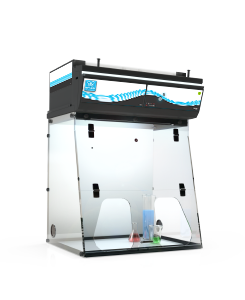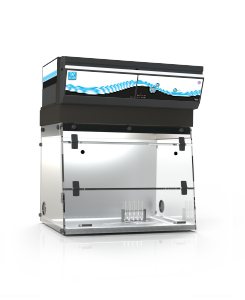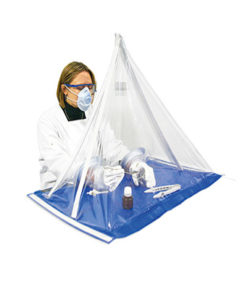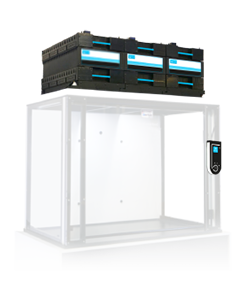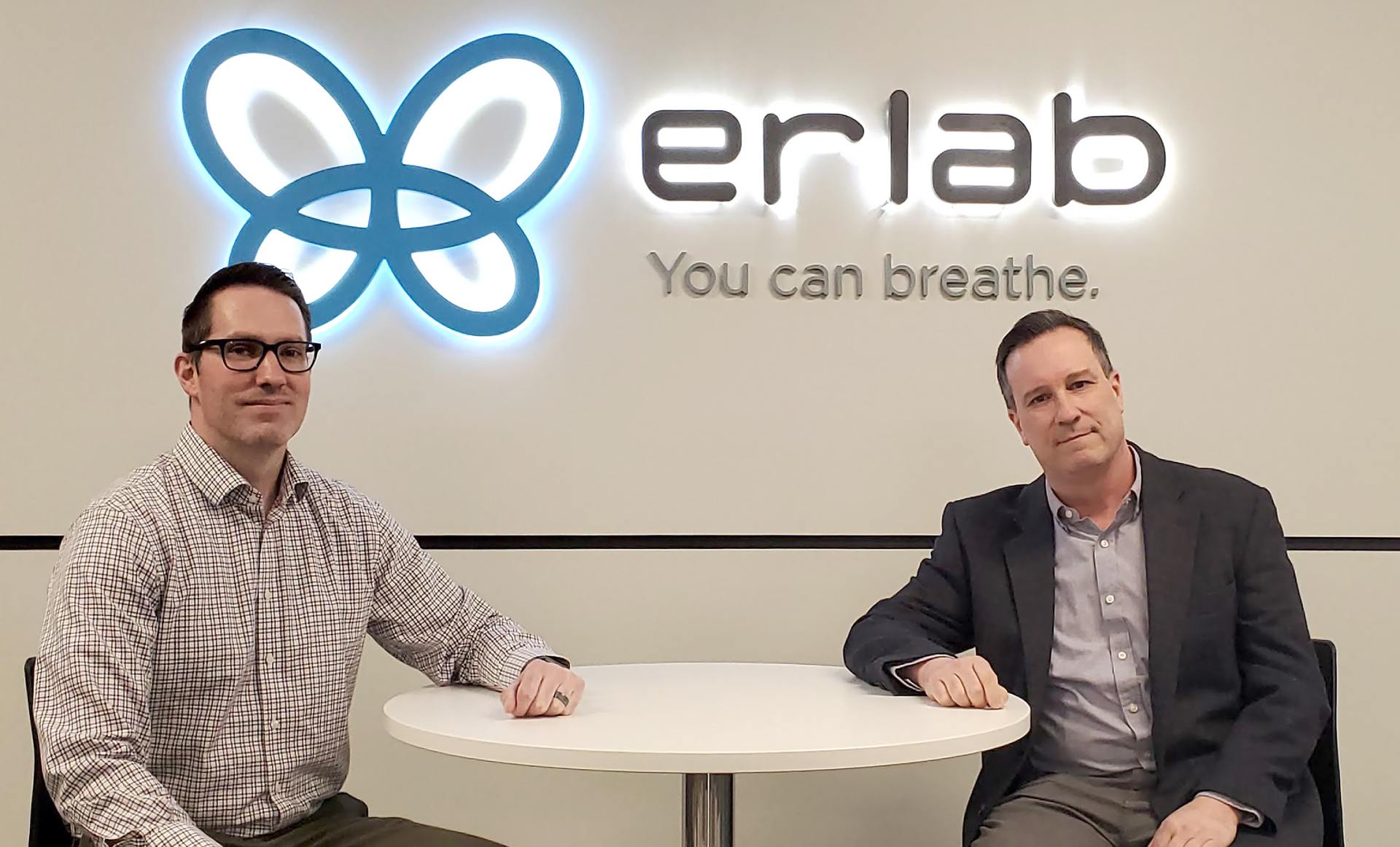Erlab’s Mark LaPointe and Tim Campbell got together to clarify some of the most common myths and misconceptions about ductless filtering hoods. Listen to the audio or view the transcript below.
Transcript:
Mark LaPointe: Hello and welcome. My name is Mark LaPointe. I am one of the newest members of the Erlab team, having joined in March of 2021. I am the Northeast ecosystem safety specialist based here in the state of Massachusetts. And I’m here today with my colleague, Tim Campbell. Tim came to Erlab in 2016 and has had several roles since then, including his current one as national sales for our health and healthcare division. Today we’re going to talk about some of the myths and misconceptions surrounding ductless fume hoods and what makes Erlab’s Ductless filtering Fume hoods different from the rest.
Tim Campbell: First off, what makes Erlab different from the rest is our commitment to safety. For over 50 years, we’ve been trying to reduce the exposure of laboratory personnel to chemicals within the lab. A lab technician has a 10 year shorter lifespan than an average person, and that is due to cumulative exposure to chemicals throughout their working life. In 1970 the first ductless Fume Hood was developed in France by the inventor and our founder, Francois Hauville, who at the time was making lab equipment. He made a shield that would slide along a lab bench, and it would be able to protect a scientist or user, from some of the experiments they were doing and protected them from splashback, bubbling explosions, but couldn’t do anything to protect against the fumes generated. As these labs were in older buildings in France they couldn’t easily add ductwork for a ducted hood. As Mr. Hauville had been a world war II veteran, he was familiar with gas masks technology which gave him an idea.
Tim Campbell: He was able to take a cartridge from a gas mask and scale it up to make it into a large carbon filter and put a fan on an enclosure to pull the air up and away. In this process, the chemical fumes would be captured in the carbon filter. And that’s also where some of the myths and misconceptions come about with ductless filtering fume hoods. Our filtration technology has come a long way since 1970. Erlab continues to invest in R & D, advancing filter technology and safety for all. 2009 was the turning point for us as our filters were able to be certified by the AFNOR NX 15-211, a new filtration standard that Erlab actually helped to write in Europe.
Tim Campbell: Basically, there are four components to the standard. The first is containment. All our hoods meet ASHRAE 110. The second is face velocity, all our hoods average, a hundred feet per minute, which is the industry standard, now where we had previously fallen a little short was on filtration efficiency and documentation. To rectify this and qualify for AFNOR we tested over 700 chemicals at six different concentrations twice with our carbon filters. This allowed us to determine how many grams of each chemical would be retained by our filters before 1% of the threshold limit value would be detected to pass them. And that’s how we were able to determine filtration efficiency. According to AFNOR NFX 15-211 standard filtration efficiency no more than 1% of the threshold limit value of the cumulative chemicals used in the hood will downstream past the exhaust of the filters.
Tim Campbell: The second component of the standard is detection. So, in the fan box, after the main carbon filter, we have a sensor that can detect breakthroughs at levels no greater than 50% of TLV by having secondary backup carbon filters on the Fume Hood. We still guarantee no more than 1% of the threshold limit value, be detected past those filters, even when the sensor detects breakthroughs past the main filters. And that is how we truly met the filter efficiency standard, part of the AFNOR NFX 15-211 standard. And that is how we lead the competition and how we keep our customers safe. Mark, can you elaborate on the Erlab guarantee of safety of our customers?
Mark LaPointe: Well, the first thing that we do in our qualifying procedure is to gain an understanding of the end-users process, which includes their applications, as well as their intended chemical usage. We are able to start this right away by having our clients complete our EValiQuest chemical questionnaire. Through this questionnaire and the information provided on the questionnaire, as in the end-users sharing the chemicals that they will use in their hood, we learn the chemicals, dilutions percentages, temperatures, handling frequencies, and quantities. It’s a lot of information, but all of this information is used so that the lab can assess the evaporation rates of the chemicals, which ultimately, will determine the lifetime of that carbon filter. This is a valuable tool for the lab to use, to identify the most appropriate chemical filtration for the end user’s safety.
Mark LaPointe: Tim, as you mentioned, our lab has compiled a chemical listing book of over 700 chemicals, which have been tested and determined suitable for use within our filtered fume hoods. There’s also a chemical shortlist of about 16 chemicals that are not safe to be used in the hoods. And these are mainly your noble gasses (any of the gaseous elements helium, neon, argon, krypton, xenon, and radon, occupying Group (18) of the periodic table). Upon successful completion of your chemical analysis, a suitable hood, a filter type, and a filter configuration will be recommended by our lab chemists. They may determine that your application(s) calls for carbon filtration, HEPA filtration, or in some cases a combination of both types. And this is what we refer to as our flex technology. So Tim, could you address the types of applications that our flex technology allows for.
Tim Campbell: Sure Mark, our flex technology allows all types of applications, and that’s also another area where myths and misconceptions about ductless fume hoods come into play. A lot of people think you can only use low volumes of chemicals and that they can’t do much in this type of hood. This is not true. With our advanced filtration technology, you can actually do R&D and advanced chemistry within our hoods. And we can guarantee that because we have a proprietary modular filtration column. On a modular filtration column, as I talked about earlier, you add a backup carbon filter. That being said, as Mark pointed out we can also add HEPA filters. So as if you’re using powders, we can add HEPA filters, and you can use powder and liquids at the same time.
Tim Campbell: It should be noted that we meet USP 800 standard where we can have HEPA filters in series. If you’re conducting nonsterile, weighing of hazardous drugs, for example. We can also put our ductless filtering fume hoods in a cleanroom. Envision all that air going through a HEPA filter and allowing you to meet your ISO rating because you are eliminating harmful particulates. You can’t put a ducted fume hood in that room because it will just take that clean air and blow it out. So you’re wasting a lot of money. With our ductless filtering fume hoods and the modular filtration column, we can put a HEPA filter on the exhaust of the carbon filter, so you can meet your ISO rating. If you have an application and think there is no way it could probably be done in a ductless fume hood.
Tim Campbell: I reached out to this other company concerning this exact issue and they said it can’t be done. They’ve never heard of that chemical, well, we say, reach out to us. There’s a good chance it can be done in our hood. Our filters are different than everybody else’s and we want to explain how. After our chemical analysis, our lab will be the first one to tell you if it can’t be done. This is a safety qualifier and we’re always looking to put your safety first. With the advancements we’ve made in filtration technology, it’s always best to reach out to us first and we will clearly and honestly let you know whether the application can be done or not. Along the lines of safety Mark, are there any types of safety alarms on our ductless filtering fume hoods?
Mark LaPointe: Uh, yes, Tim, there are. So, our smart light technology is featured on all our ductless filtering fume hoods. The unit will communicate via pulsing light, letting the end-user know that everything’s either in proper working order or when there’s an issue that is presenting itself. And this is done through both visual and audible alarms for the end-user. So there’s a light on the control panel that will be solid when the unit is functioning properly. If there is an issue with the hood, the light will be pulsing instead of remaining solid. So that’s a visual indicator to know that something’s occurring that needs attention. The audible alarm sounds if there is a face velocity issue. In this case, you will hear two audible beeps, if there is a filter efficiency issue you will hear three beeps.
Mark LaPointe: For any issues with the fan, four audible beeps would be heard. The visual light is also a nice type of backup. For example, say that you’re in the lab space, but you’re not in direct proximity to the hood. You might not hear the alarm, but you could look across the lab space and see the light, either solid or pulsing, letting you know that there’s an issue. As an additional service, we also assign a filter safety specialist to every customer. The filter safety specialist is available to answer any questions and assist with any filter-related issues that may arise. They’re also there to remind you when it’s nearing the time to replace your filter. So, it’s not something that you’re necessarily going to have to remember to do on your own. Tim, can you share how easy is it to integrate Erlab’s ductless filtering fume hoods into your lab space?
Tim Campbell: Well Mark, I’m glad you asked because it’s very simple. As long as you complete the chemical questionnaire and let us perform the filtration efficiency analysis we had talked about. Typically, we’re averaging about a two-year filter lifetime or 18 to 24 months depending on usage. So that is quite a long time. Basically, you just need a standard power outlet in your room. We can place our hoods on existing benches. We do have carts for some of our smaller units to make them easy to move around and they’re a lot different than the traditional ducted fume hoods that I’m sure most of you have in your labs. Think of those as the energy hog of the lab. The ducted hood uses three and a half times more energy than an average US home per year.
Tim Campbell: Ducted fume hoods are making your chemical exposure the outside world’s problem by dispersing it to the outside environment. Our ductless filtering fume hood does not pollute the outside. There’s no ductwork, so it could be placed anywhere in the lab. So you can place them anywhere or rearrange your lab easily. Then if you change your mind, the next week you can move it somewhere else within your lab. It’s not stuck in place like a ducted fume hood. So look around your lab and see how many ducted fume hoods you have that are wasting energy when you could be using ductless filtering hoods. So again, they’re very easy to set up. We are the experts and have been since 1968 when the company was started. Consider us ‘your’ experts and know that we’re there to protect you by reducing your exposure to chemicals within the lab. Thank You!



